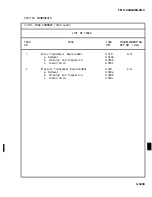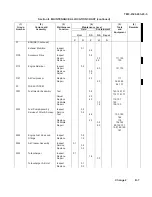
Section I. INTRODUCTION
THE ARMY MAINTENANCE SYSTEM (
A
M
S
)
This introduction provides a general explanation of all maintenance and repair functions authorized at the two
maintenance levels under the Two-Level Maintenance System concept.
The MAC (immediately following the introduction) designates overall authority and responsibility for
the performance of maintenance functions on the identified end item or component. The application of the
maintenance functions to the end item or component shall be consistent with the capacities and capabilities of
the designated maintenance levels, which are shown on the MAC in column 4 as:
Field -
includes two subcolumns, Unit C (operator/crew) and O (unit/organizational
maintenance) and Direct Support (F) maintenance
Sustainment -
includes two subcolumns, general support (H) and depot (D).
The tools and test equipment requirements (immediately following the MAC) list the tools and test equipment
(both special tools and common tool sets) required for each maintenance function as referenced from the MAC.
The remarks (immediately following the tools and test equipment requirements) contain supplemental
instructions and explanatory notes for a particular maintenance function.
MAINTENANCE FUNCTIONS
Maintenance functions are limited to and defined as follows:
1.
Inspect. To determine the serviceability of an item by comparing its physical, mechanical, and/or electrical
characteristics with established standards through examination (e.g., by sight, sound, or feel).
2.
Test. To verify serviceability by measuring the mechanical, pneumatic, hydraulic, or electrical
characteristics of an item and comparing those characteristics with prescribed standards on a scheduled
basis, i.e., load testing of lift devices and hydrostatic testing of pressure hoses.
3.
Service. Operations required periodically to keep an item in proper operating condition: e.g., to clean
(includes decontaminate, when required), to preserve, to drain, to paint, or to replenish fuel, lubricants,
chemical fluids, or gases.
4.
Adjust. To maintain or regulate, within prescribed limits, by bringing into proper position, or by setting the
operating characteristics to specified parameters.
5.
Align. To adjust specified variable elements of an item to bring about optimum or desired performance.
TM
9-2320-283-20-3
APPENDIX B
MAINTENANCE ALLOCATION CHART
Change
2
B-1
Summary of Contents for M915A1
Page 10: ......
Page 17: ......
Page 59: ......
Page 130: ......
Page 155: ......
Page 378: ...TM 9 2320 283 20 3 CAB AND BODY 3 264 OUTSIDE FRONT HANDLE REPLACEMENT Continued 3 1551...
Page 622: ...TM 9 2320 283 20 3 GAGES NONELECTRICAL 3 309 TACHOGRAPH REPLACEMENT Continued TA 237846 3 1795...
Page 669: ......
Page 673: ......
Page 705: ......
Page 707: ......
Page 717: ......
Page 737: ......
Page 738: ......
Page 739: ......
Page 740: ......
Page 741: ......
Page 742: ......
Page 743: ......
Page 744: ......
Page 745: ......
Page 746: ......
Page 748: ......
Page 756: ...PIN 054576 000...










































